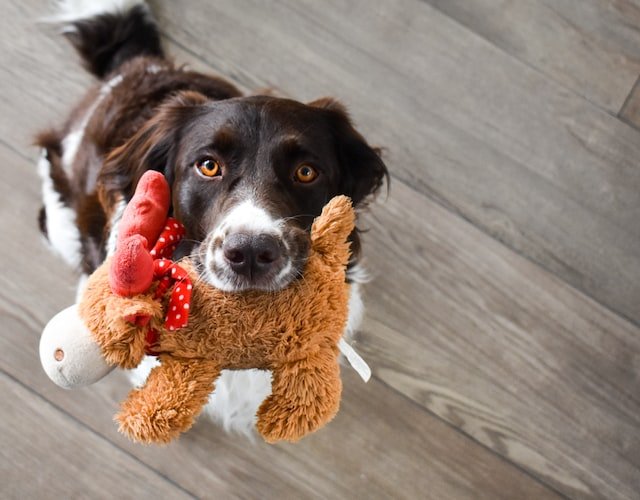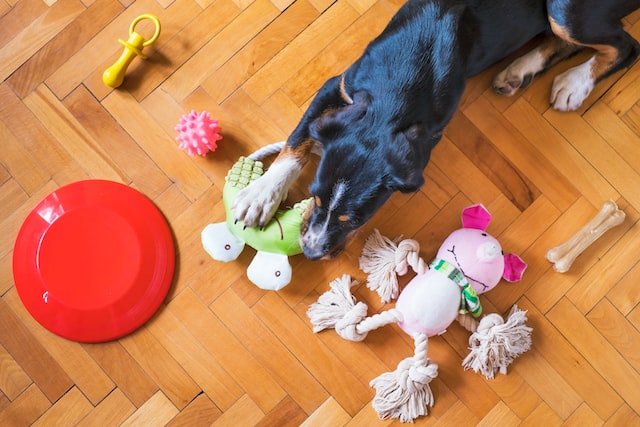Like our children, dogs and cats need to play, and they appreciate a toy that stimulates and activates their primal instincts. But what aspects should you keep in mind when looking for perfect dog toys or cat toys? In the following article, we will try to list precisely what you should keep in mind when selecting cat or dog toys, and we will explain why they are essential for the healthy development of your furry friend.
What to Look for in a Perfect Dog Toys?
The best dog toys are those that encourage your pet to exercise. They can be anything from fancy squeaking toys to a typical tennis ball. But when choosing a toy for your dog, you need to consider the roughness of the material, the age of your four-legged friend, and the way he will use the toy.
For example, do you have a dog between three and seven months old? Then he’s teething and will chew almost anything that catches his attention. To limit the wreckage, he will do in your home, and to save your shoes, give him as many soft toys as possible to chew on. It would be best if you didn’t give him toys made of materials that are too hard to chew through, at least not till he is more mature, as he won’t get positive feedback from them, and he may not discover the strength of his bite, which can be a problem when he reaches adulthood.
Size Matters When Talking About Dog Toys

If you have a Newfoundlander as a pet, you can give him any toy, and he will do great with it. But what if you have a Chihuahua? To say there is a difference between these two breeds is the understatement of the year. Toys should also be designed with size in mind when talking about your furry friends, as the differences between breeds can be astonishing.
If you’d give a Chihuahua a tennis ball to chase, you’d give a Newfoundlander a football. If you gave a Dachshund a chew toy the size of your palm, a Great Dane would probably get one the size of your entire forearm.
But What Kind of Toys are We Talking About?
First of all, we have to talk about throwing balls. They are ideal as dog and cat toys while being a cheap and safe alternative to bring out your pet’s natural hunting instinct. As much as we like to think our animals are entirely domesticated, there is still a part of them that activates when adequately stimulated. The movement of a rolling ball reminds your pet of a running vermin, while the annoying sound of a squeaking toy resembles the sound of an animal caught in its jaws. Is it a bit macabre? Yes, but that’s nature.
What About Cat Toys?
As with dogs, the ideal cat toys for your furball should stimulate their hunting instinct. Kittens are not as profoundly tame as dogs and are constantly looking to hunt creatures smaller than themselves. That’s why they also started hanging around our settlements in ancient times because where there were people and food, there were also vermin.
You can’t use the same toys for a cat as for a dog. Try playing tug-of-war with your cat, for example, and you’ll probably notice in real-time all the extraordinarily different ways she’ll ignore you. But you can get creative. Scratching posts, for example, can be an ideal toy that stimulates cats’ instinct to, well, scratch things. These toys also have the added benefit of keeping their nails a little duller, which in the long run, can prove invaluable to the health of your furniture.
Perfect Dog Toys that Build Their Agility
Cats are not particularly active creatures. In fact, we could consider them downright lazy, sleeping up to fourteen hours a day. But what they do have in spades is agility. Climbing towers can be ideal for your cat to keep their flexibility into old age. Furthermore, cats generally like heights, and it wouldn’t be unusual to find your furry friend sleeping soundly perched on these climbing towers.
Other cat toys that work their reflexes and agility are fishing wands. They stimulate cats’ natural hunting instincts and are some of their favorites. And if you want a low-cost alternative that can prove particularly effective, try exhausting your cat with a laser pointer.
Toys You Should Avoid

The truth is that in the right circumstances, any object can be a toy for your pet. Do you have a plastic wrapper that you dropped on the floor? Then it has probably become your dog’s new chewing toy. Do you have a small ping-pong ball that slipped from your hands? Then it’s perhaps now getting chased by your cat. But these are some terrible examples of pet toys. And the reason is simple, the risk of choking. so, instead of these toys, you can try the puzzles toys that actually help to keep your dog busy.
Both dog and cat toys should be made of materials that do not present a choking hazard to your pet. Plushies, for example, are popular dog toys, but they are not designed to resist bites, and most of the time, their contents spread all over the house, which leads to a colossal mess or even, in unfortunate cases, can lead to the suffocation of your four-legged friend. And the same happens with cats. Felines may not have the same instinct to gnaw that dogs have, but they still tend to swallow their prey once it is caught, and if the toy you gave them is too small, then there is a risk of choking.
Plenty of toys on the market are available for every pocket and play type. We all know you love your pet and want only the best for them, so it is best to go for professionally designed toys that are safe and durable.

